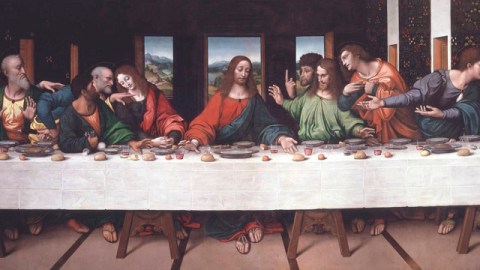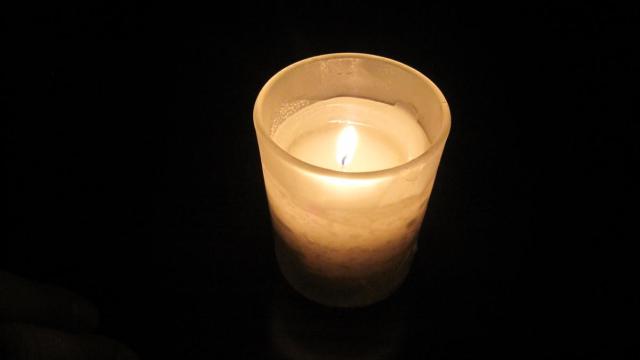Can We Ever Restore Leonardo’s “Last Supper”?

Upon seeing in person Leonardo da Vinci’s The Last Supper, American novelist Henry James pithily dubbed it “the saddest work of art in the world.” War, weather, da Vinci’s own failed experimentation, and, most of all, time have taken such a collective toll on a work that Renaissance contemporaries called miraculous and instantly recognized as a game changer in art that we most likely may never see it in anything close to its original glory. In Leonardo and The Last Supper, Ross King performs a different, but still glorious restoration of da Vinci’s mural masterpiece in all the color, detail, and depth of the original. King brings to the table all the social history surrounding the work that makes the story of The Last Supper’s creation and survival itself sound like a miracle.
The title could easily have been Leonardo, Ludovico, and The Last Supper, as Ludovico Sforza, Duke of Milan, patron of da Vinci, and commissioner of The Last Supper plays almost as big a part in the story from beginning to end as the artist himself. Ludovico, known as il Moro, picked Leonardo as his third choice for a mammoth bronze equestrian statue memorializing his father, Francesco. Unfortunately, Ludovico’s political and military exploits created an imminent demand for bronze, so the 75 tons promised to Leonardo went instead into heavy artillery. “The bronze horse was not the first commission that Leonardo, for various reasons, had been unable to complete,” King explains. “He was someone who promised much, who dreamed of impossible miracles. Yet thus far he had yielded a body of work that, however impressive, was still unhappily disproportionate to his talents.” King quickly erases the portrait of Leonardo the Renaissance Genius and paints in the then-true picture of an artist reaching his forties with little tangible to show for all his gifts and high-flying ideas.
The Leonardo King restores to us is much more human, and much more interesting than the mythical Renaissance man. An insatiable autodidact who amused onlookers with eccentricities such as mountain climbing well before such a thing was considered sport, Leonardo the procrastinator “frustrated by the extremely high standard he set for himself in his quest for a new visual language” is in King’s eyes cursed by an exactness of observation well beyond that of his contemporaries. da Vinci looked harder than anyone else—whether climbing higher to look more closely at the sky or digging deeper to see how joints and muscles work—and strove harder to put all of that into his art.
Woven with this story of the artist is an equally intricate story of the mural itself. King explains how da Vinci searched the streets for models for the apostles before finally settling on “gossiping bench sitters” in the piazza. Whereas predecessors such as Domenico Ghirlandaio painted tranquil Last Suppers, Leonardo would infuse the scene with double drama as Jesus reaches out with his right hand to finger Judas as the traitor among them, while simultaneously reaching out with his left hand to the bread of the Eucharist. While others painted in the duller palette necessitated by the chemical action of the lime in the fresco plaster, da Vinci went for a wider and bolder palette by painting in oil on top of rather than into the plaster (and paid a dear price for posterity with that choice). The result may have been something like a copy (shown above) done shortly after by Giovanni Pietro Rizzoli, a student of Leonardo’s known better as Giampietrino. In Giampietrino’s better-preserved copy, we get a glimpse of what Leonardo’s colors and details may have looked like at the moment of creation, yet even that glimpse only tantalizes us with the idea of the real thing.
As Leonardo dealt with painting the massive scene, the devilishly thieving ways of his assistant and companion Salai, the logistics of purchasing rare pigments such as ultramarine (the royal blue of Jesus’ tunic, more commonly found associated with the Virgin Mary), the development of a language of hand gestures to express silently the tumult of the dinner, and his own anxieties over realizing his potential, il Moro’s faltering political fortunes added the stress not only of not being able to finish, but also the distinct possibility of an invading army taking aim at the painting or, perhaps worse, taking it away as plunder. King introduces the circuslike world of Italian and European politics of the time in an understandable way that emphasizes the human and cultural costs while keeping the cast of characters to a manageable minimum.
But before you think that Leonardo and The Last Supper is a straightforward approach to the most rambling and wide-reaching mind in history, let me offer just a handful of the wonderful digressions that always circle back to the man and the work: how da Vinci’s own vegetarianism led to a vegetarian (or pescetarian) Last Supper of fish and sliced eel; how Leonardo’s lefthandedness set him apart from a society still wary of the “sinister” hand; how Leonardo recognized the science of complementary colors and colored shadows centuries before the Impressionists founded a whole revolution on those ideas; how Judas’ capsizing of a salt cellar in the painting spills out into a whole world of meanings. Leonardo and The Last Supper goes off in many directions, but always arrives at its destination.
Author of Brunelleschi’s Dome,The Judgment of Paris: The Revolutionary Decade That Gave The World Impressionism, and Michelangelo and the Pope’s Ceiling, King continues his reign as the premier art historian for a popular audience. Written in a suspenseful, thrilling, yet never dumbed down style, King captivates by plunging the reader into the heart of the situation, as if you were right there with the artist as politics, religion, and war whirl around him. For anyone who’s followed King’s career, Leonardo and The Last Supper will suit your appetite and leave you hungry for more.
“Tell me if anything was ever done,” Leonardo lamented in his notebooks. After the triumph of finally finishing The Last Supper came the fall—first of Lodovico to his enemies, then of the paint from the wall, and finally of Leonardo himself, who eventually went to work for King Louis XII of France, the man who brought da Vinci’s previous patron il Moro down. What we think of as the triumph of the Mona Lisa as the greatest painting on Earth won’t happen until the 20th century. In Leonardo’s time, La Gioconda was just another undelivered commission. But just as the 22-year conservation project concluded in 1999 (which relied on Giampietrino’s copy, and others) brought us The Last Supper as no one had seen it in centuries, Ross King’s Leonardo and The Last Supper restores both the man and the mural while scraping away the myths surrounding both. More than just a delightful treat of art and history, Ross King’s Leonardo and The Last Supper serves up a fulfilling meal of human striving for greatness and human endurance despite the odds.
[Image: Giovanni Pietro Rizzoli, called Giampietrino (active 1508-1549). The Last Supper (detail), ca. 1520. Image source here.]
[Many thanks to Bloomsbury Publishing for providing me with a review copy of Ross King’s Leonardo and The Last Supper.]





